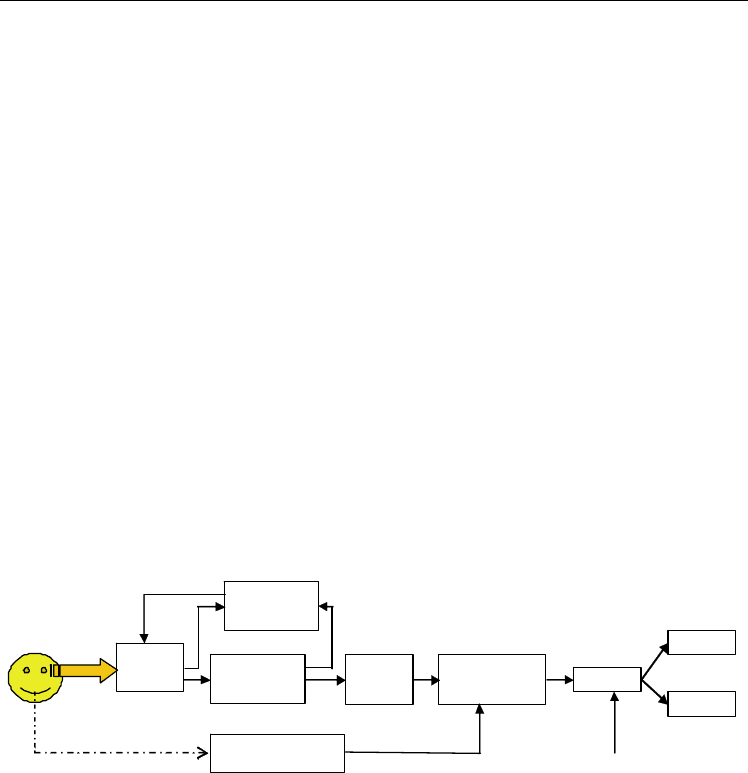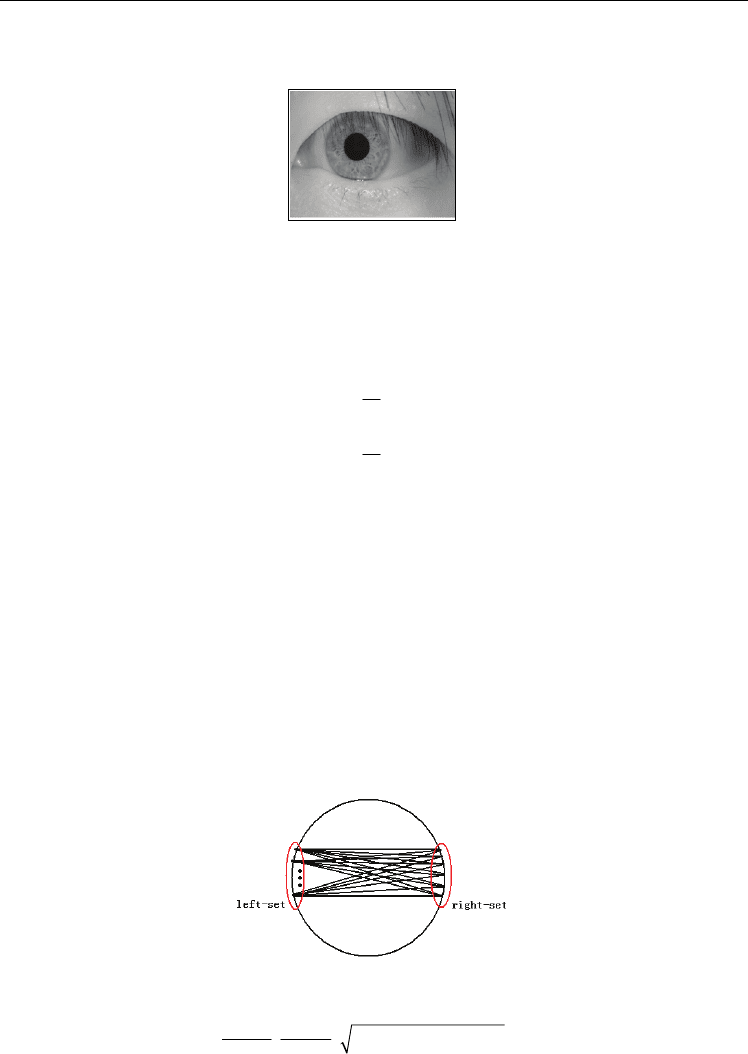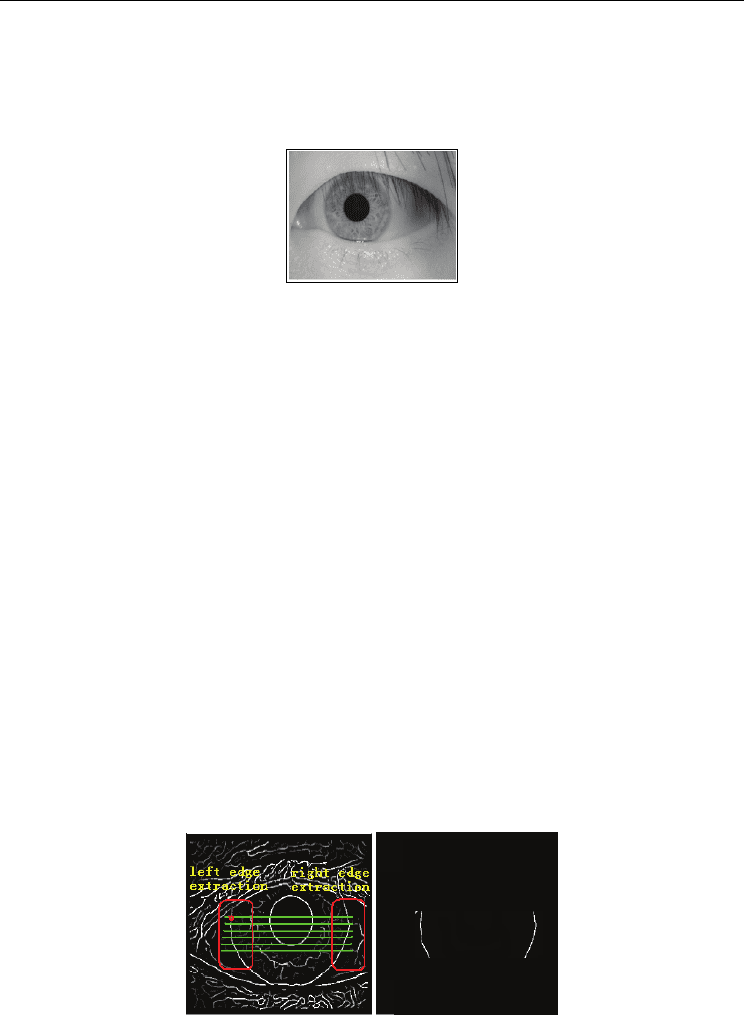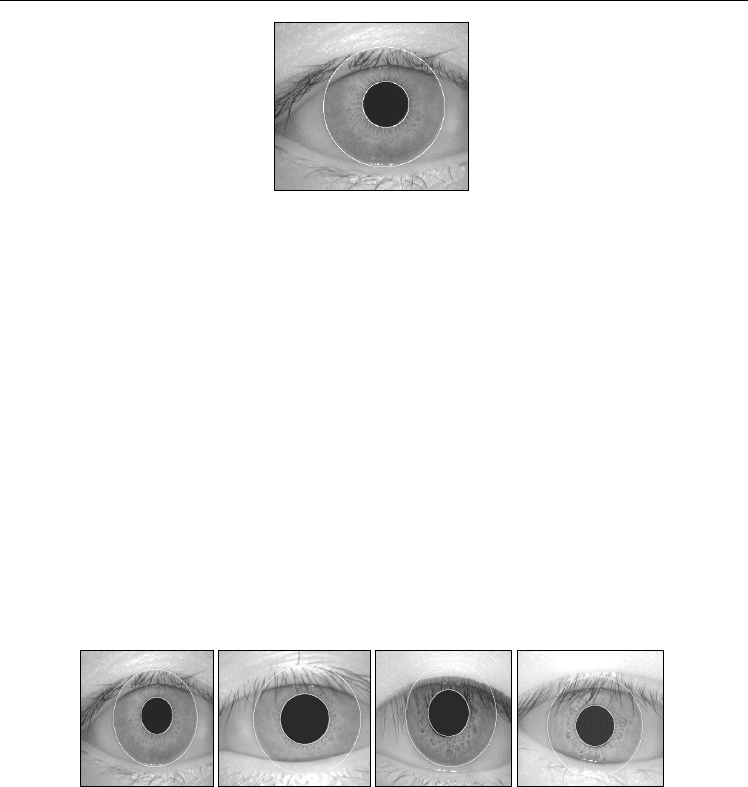Yang J., Nanni L. (eds.) State of the Art in Biometrics
Подождите немного. Документ загружается.


Temporal Synchronization and Normalization of Speech Videos for Face Recognition
159
were tested on a real world database of considerable size and illumination/speech variation
with adequate results.
Then we have presented a temporal synchronization algorithm based on mouth motion for
compensating variation caused by visual speech. From a group of videos we studied the lip
motion in one of the videos and selected synchronization frames based on a criterion of
significance. Next we compared the motion of these synchronization frames with the rest of
the videos and selects frames with similar motion as synchronization frames. For evaluation
of our proposed method we use the classical eigenface algorithm to compare
synchronization frames and random frames extracted from the videos and observed an
improvement of 4%.
Lastly we have presented a temporal normalization algorithm based on mouth motion for
compensating variation caused by visual speech. Using the synchronization frames from the
previous module we normalized the length of the video. Firstly the videos were divided
into segments defined by the location of the synchronization frames. Next normalization
was carried out independently for each segment of the video by first selecting an optimal
number of frames and then adding/removing frames to normalize the length of the video.
The evaluation was carried out by using a spatio-temporal person recognition algorithm to
compare our normalized videos with non-normalized original videos, an improvement of
around 4% was observed.
6. References
Blanz, V. and Vetter, T. (2003). Face recognition based on fitting a 3D morphable model.
PAMI
, Vol. 9, (2003), pp. 1063-1074
Matta, F. Dugelay, J-L. (2008). Tomofaces: eigenfaces extended to videos of speakers, In
Proc. of International Conference on Acoustics, Speech, and Signal Processing
, Las Vegas,
USA, March 2008
Lee, K. and Kriegman, D. (2005). Online learning of probabilistic appearance manifolds for
video-based recognition and tracking,
In Proc of CVPR, San Diago, USA, June 2005
Georghiades, A. S. Kriegman, D. J. and Belhumeur, P. N. (1998). Illumination cones for
recognition under variable lighting: Faces, In Proc of CVPR, Santa Barbara, USA,
June 1998
Tsai, P. Jan, T. Hintz, T. (2007). Kernel-based Subspace Analysis for Face Recognition,
In
Proc of International Joint Conference on Neural Networks
, Orlando, USA, August 2007
Ramachandran, M. Zhou, S.K. Jhalani, D. Chellappa, R. (2005). A method for converting a
smiling face to a neutral face with applications to face recognition, In Proc of IEEE
International Conference on Acoustics, Speech, and Signal Processing
, Philadelphia,
USA, March 2005.
Liew, A.W.-C. Shu Hung, L. Wing Hong, L. (2003). Segmentation of color lip images by
spatial fuzzy clustering,
IEEE Transactions on Fuzzy Systems, Vol.11, No.4, (2003),
pp. 542-549
Guan, Y.-P. (2008). Automatic extraction of lips based on multi-scale wavelet edge detection,
IET Computer Vision, Vol.2, No.1, March 2008, pp.23-33
Canzler, U. and Dziurzyk, T. (2002). Extraction of Non Manual Features for Videobased Sign
Language Recognition,
In Proceedings of the IAPR Workshop on Machine Vision
Application
, Nara, Japan, June 2002

State of the Art in Biometrics
160
Michael, K. Andrew, W. and Demetri, T. (1987). Snakes: active Contour models, International
Journal of Computer Vision
, Demetri, Vol. 1, (1987), pp. 259-268
Thejaswi N. S and Sengupta, S. (2008). Lip Localization and Viseme Recognition from Video
Sequences,
In Proc of Fourteenth National Conference on Communications, Bombay,
India, 2008
Chan, T.F. Vese, L.A. (2001). Active contours without edges,
IEEE Transactions on Image
Processing
, Vol.10, No.2, (2001) pp.266-277
Bourel, F. Chibelushi, C. C. and Low, A. (2000). Robust Facial Feature Tracking,
In
Proceedings of the 11th British Machine Vision Conference,
Bristol, UK, September 2000
Fox, N. O’Mullane, A. B. and Reilly, R.B. (2005). The realistic multi-modal VALID database
and visual speaker identification comparison experiments,
In Proc of 5
th
International Conference on Audio- and Video-Based Biometric Person Authentication
,
New York, USA, July 2005
Turk, M. and Pentland, A. (1991). Eigenfaces for recognition
, J. Cog. Neurosci. Vol. 3, (1991)
pp. 71–86
Ugiyama, K. Aoki, T. Hangai, S. (2005). Motion compensated frame rate conversion using
normalized motion estimation,
In Proc. IEEE Workshop on Signal Processing Systems
Design and Implementation
, Athens, Greece, November 2005.
Wolberg, G. (1996). Recent Advances in Image Morphing, In Proceedings of the
International Conference on Computer Graphics, USA, 1996
Huang, C.L. and Huang, Y.M. (1997). Facial Expression Recognition Using Model-Based
Feature Extraction and Action Parameters Classification,
Journal of Visual
Communication and Image Representation
, Vol. 8, (1997), pp. 278-290
Akutsu, A. and Tonomura, Y. (1994). Video tomography: an efficient method for
camerawork extraction and motion analysis,
In Proceedings of the Second ACM
international Conference on Multimedia
, USA, 1994
Canny, J. (1986). A computational approach to edge detection, IEEE Trans. Pattern Anal.
Mach. Intell
. Vol. 8, (1986), pp. 679-698
Part 3
Iris Recognition
8
Personal Identity Recognition
Approach Based on Iris Pattern
Qichuan Tian
1
, Hua Qu
2
, Lanfang Zhang
3
and Ruishan Zong
1
1
College of electronic and information engineering,
Taiyuan University of Science and Technology,
2
College of Science, Tianjin Polytechnic University,
3
Taiyuan University of Science and Technology
China
1. Introduction
Personal identification based on biometrics technology is a trend in the future. Traditional
approaches, for example, keys, ID cards, username and password, are neither satisfactory
nor reliable enough in many security fields, biometrics authorizations based on face, iris,
fingerprint have become a hot research filed. In those methods, iris recognition is regarded
as a high accuracy verification technology, so that many countries have the same idea of
adopting iris recognition to improve the safety of their key departments.
The human iris can also be considered a valid biometrics for personal identification [Richard
P W, 1996]. Biometrics recognition based on iris patterns is a hotspot as face recognition and
fingerprint recognition recently years. The iris is the colored ring on the human eye between
the pupil and the white sclera. Lots of physical biometric can be found in the colored ring of
tissue that surrounds the pupil, such as corona, crypts, filaments, flecks, pits, radial furrows
and striations. The iris features can be encoded by mathematical representation so that the
patterns can be compared easily.
In real-time iris recognition application system, iris localization is a very important step for
iris recognition. The iris regions segmentation accuracy and localization real-time
performance will affect the whole recognition system’s correct rate and effectiveness for
large-scale database.
Because iris region is a small object and has low grey value, it is very difficult to capture high
contrast iris image clearly. In order to improve iris image contrast, usually some illuminations
such as near infrared light source are used to increase intensity; however these illuminations
may result in some faculas in iris image and affect iris segmentation and iris features.
Here, we will discuss iris recognition system’s algorithm, all steps of iris recognition system
will be introduced in details. Finally, we will show the experimental results based on iris
database.
2. Iris recognition system principle
Iris feature is convenience for a person to prove his/her identity based on him/her
biometrics at any place and at any time. Iris recognition may become the most important

State of the Art in Biometrics
164
identify and verify approach in many departments such as navigation, finance, and so
on.
Iris recognition system main includes iris capturing, image pre-processing, iris region
segmentation, iris region normalization, iris feature extraction and pattern matching. Every
part is very important for correct recognition person identity.
There are plenty of features in iris regions of human eye image. Because iris is a small and
black object, iris image capturing is not an easy work. Iris must be captured at a short
distance about 4cm-13cm and under a good illumination environment. Near infrared is a
better light resource for many visible image recognition systems, such as face recognition.
Near infrared can perform good illumination for enhancing image contrast and it is
harmless to human eyes. In order to capture ideal iris image, it is necessary that a friend
cooperation of user and captured camera is the base of iris recognition. A good cooperation
can decrease the quantity of iris pre-processing and improve iris recognition real-time
character. However, the demand for cooperation may affect user’s feeling and result in users
doesn’t accept iris recognition system because of high rejection rate. So, many researchers
begin to study imperfect iris recognition theory under in-cooperation conditions, iris
recognition system will have more width application fields based on imperfect iris
recognition theory under in-cooperation conditions.
Because of motion blur or defocus blur or the occluder like eyelids and eyelashes, objective
evaluation algorithm of image quality can be used to select a high quality eye-image for iris
recognition. Now, some literatures evaluate images by using features of frequency domain
and spatial domain and by calculating the rate of effective iris regions’ pixels to whole iris
regions’ pixels. Image quality evaluation is a step to select an eye-image for iris recognition,
and this procedure can decrease processing work according to lower quality eye-images.
Identity declare
Image qualit
y
evaluation
Iris region
segmentation
Feature
extraction
Reference identity
tem
p
lates
Iris
capturing
Similarity
Calculation
Decision
Reject
Accept
Threshold
Fig. 1. Iris recognition system principle
3. Iris region segmentation
3.1 Iris segmentation background
In iris recognition system, iris region is the part between pupil and sclerotic, the aim of iris
boundary localization is to locate the boundary of iris/pupil and the boundary of
iris/sclerotic. Both inter boundary and outer boundary of iris are alike circles, so many iris
localization methods are to locate iris boundaries using circle detector. John Daugman’s
Integral-differential method and Wildes’s Hough transform method are effective methods
for iris localization precision [John Daugman, 1993; Richard P W, 1997], but those methods
cost lots of compute times because of large parameters search space. In order to improve iris
localization real-time performance, many modified algorithms adopting some known

Personal Identity Recognition Approach Based on Iris Pattern
165
information of iris image are introduced in other literature. Pupil position can be estimated
easily because of the lower grey level in pupil region and then iris boundary localization
speed can be improved based on pupil position localization. Fast iris localization based on
Hough transforms and inter-gradational method can be realized at the base of pupil position
estimation [Tian Qi-chuan, 2006].
Usually, there is much interference in iris regions, and the interference can cause iris texture
and grey value change, so high accuracy iris segmentation also need to remove the
interference.
3.2 Iris boundary localization based on Hough transforms
In iris boundary localization methods, John Daugman’s Integral-differential method and
Wildes’s Hough transform method with high iris localization precision are the most popular
and effective methods, but the real-time character of those methods can’t be satisfied. At the
same time, these methods also have its disadvantages. Integral-differential method will be
affected by local gradient maximum easily and then iris boundaries are located in these
wrong positions, main reason is that light-spots will produce great gradient change. Hough
transform for circle parameters voting can decrease local gradient effect, but the threshold
for extracting edge points will affect the number of edge points and finally these edge points
will cause iris boundary localization failure.
Fast boundaries localization based on prior pupil centre position estimation can improve iris
boundary localization real-time, the main idea of this algorithm is: firstly, pupil centre
coarse localization, secondly, edge detection based on canny operation; thirdly, iris inter
boundary localization in a small image block selected; fourthly, edge extraction based on
local grey gradient extreme value; finally, outer boundary localization in image block
selected based Hough transform.
3.2.1 Pupil center coarse localization
In eye image, there are obvious lower grey levels in pupil regions than other parts as shown
in Fig.2. Firstly, a binary threshold can be selected based on Histogram adopting p-tail
method. Usually, iris image is captured in a distance, so pupil size is limited to a range in
eye image, we can select threshold depend on the set rate of pupil pixels number to whole
image pixels in histogram. Faculas can be seen in eye image as shown in Fig.2, these
interferences must be removed, or they will affect iris boundary localization.
a) Original eye image b) Binarized result c) Pupil coarse estimation
Fig. 2. Pupil centre coarse localization
According to high grey pixels caused by faculas in pupil parts, morphological operation can
be used for filling with these holes and remove noise such as eyelashes by using close-
operation. So the original image of Fig.2 (a) can be transformed into the image of Fig.2 (b).

State of the Art in Biometrics
166
After removing light-spots, pupil centre position will be estimated more accuracy, it is
helpful to precision iris localization.
Fig. 3. Results of morphological operation
We can find a position using a moving window, when the window move to a position, the
number of pixels in the window can be calculated, thus the position responding to the
minimum sum can be regarded as pupil centre. The ordinate parameters (x, y) of pupil
centre can be calculated as formula (1).
1
1
1
1
N
i
i
N
i
i
xx
N
y
y
N
=
=
⎧
=
⎪
⎪
⎨
⎪
=
⎪
⎩
∑
∑
(1)
Where,
(,)
ii
xy indicate 0-pixel ordinates, N is the number of 0-pixel points.
Pupil centre coarse estimation result is shown in Fig.2 (c).
3.2.2 Iris inter boundary delicate localization
At the base of pupil centre coarse localization, small region as n*n can be selected for pupil
boundary localization, in this small region, we can achieve several local gradient extreme
value points as binary edge points, then these points are divided into two sets (named left-
set and right-set) according to their position direction to the pupil centre estimation, and we
can take every point of left-set and every point of right-set as a pair points, so we can
achieve n*n pairs data, the centre and radius of pupil boundary can be confirmed by every
pair data voting for
(,,)hxyr as follows formula (2). Fig.4 is the principle of pupil boundary
localization.
Fig. 4. Result of pupil boundary localization
22
,,()()
22
ijij
ij ij
xxyy
hxxyy
++
⎛⎞
−
+− ++
⎜⎟
⎝⎠
(2)

Personal Identity Recognition Approach Based on Iris Pattern
167
When finished all voting, we can achieve the pupil boundary parameters by using formula
(3). Fig.5 is the pupil localization result.
{
}
(,,)max (,,)
ppp
Hx
y
rhx
y
r= ∪
(3)
Fig. 5. Results of morphological operation
3.2.3 Iris outer boundary localization
In this paper, in order to realize iris boundary fast localization, a new method is proposed to
extract iris edge points by using local gradient extreme value for each line of image, and
then to achieve iris boundaries’ parameters based on new voting approach. The upper
eyelid and the lower eyelid often corrupt iris outer boundary, so we locate iris outer
boundary by using part edge information.
Because iris outer boundary has lower gradient than iris inter boundary (pupil boundary), it
is very difficult to extract edges by comparing with a set threshold. If the threshold for edge
extraction in iris gradient image is lower, then the more edge points extracted will be not
helpful to improve real-time character of iris recognition system and the more edge points
also may cause iris localization failure; if the threshold for edge extraction in iris gradient
image is higher, then many edge points may be lost and it also can cause iris localization
failure. So, we want to extract edge information by using local grey gradient extreme value,
then to locate outer boundary based on Hough transform.
Here, we don’t select the threshold to extract edge points, instead of this, while we achieve
binary edge points by comparing every line’s grey gradient extreme value. The principle is
shown in Fig.6. Same as pupil region selection, an image block for iris outer boundary
localization can be selected so that we can locate iris boundary in a small region. Because
upper eyelid usually obstruct iris region, we can select a small region for iris outer boundary
localization as shown in Fig.6. Thus, based on Hough transform, we can adopt fewer edge
points to achieve accuracy iris boundary. Fig.7 is the results of iris boundary localization.
a) Gradient image b) Binary image
Fig. 6. Binary edges extract principle based on line grey gradient extreme value

State of the Art in Biometrics
168
Fig. 7. Iris boundary localization results
Iris boundary localization algorithm is as follows:
Step 1. Pupil centre coarse localization;
Step 2. Select a small image block and extract edge information based on canny operator;
Step 3. Pupil boundary localization based on Hough transform;
Step 4. Select a small image block and extract edge information based on line’s grey
gradient extreme value;
Step 5. Iris outer boundary localization based on Hough transforms.
Due to improve localization speed and localization accuracy, taking the advantage of the
grey information, we decrease the number of edge points and parameter range down to a
small range to locate iris boundary.
3.3 Interference detection
There are many images looks like which shown in Fig.8. In iris images captured,
interference, such as eyelids, eyelash and facula, will affect iris effective information for iris
recognition [Wai-Kin Kong & David Zhang, 2003], we must remove these interferences
between pupil boundary and iris outer boundary. From image #1 to image #4, we can see
that eyelids cover iris’s upper part and lower part usually. So, to detect boundary of eyelid
is an important step in accuracy segmentation iris region.
a) Image #1 b) Image #2 c) Image #3 d) Image #4
Fig. 8. Eye images
In order to achieve high accuracy segmentation and extract effective iris information in iris
region, interference of eyelids, eyelash and faculas should be detected at a high accuracy
rate [W. Kong & D.Zhang, 2001; Tian Qi-chuan, 2006]. Interferences detection is the other
important aspect in segmenting iris region. Some image processing technologies are used to
improve robustness of the algorithm to remove the interference of eyelash, light spots and
image contrast. For every eyelid, using three-line detection can approach the eyelid. In order
to get effective iris features, self-adaptive algorithms of detecting eyelid and eyelash and
faculas are introduced in iris segmentation.
In some literature, four kinds of methods are introduced to remove eyelids as shown in
Fig.9. The first method remove eyelids by using arc Hough transform to fit eyelid’s
